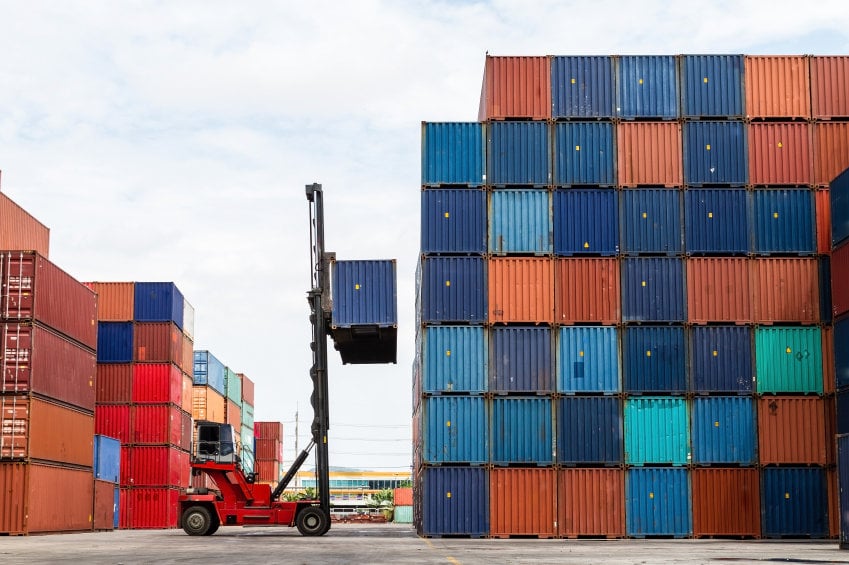This week, most of the files that we have handled surfaced the issue of “Overweight Containers”, therefore I have decided that it was time to write a few words about this ongoing issue.
On each day, there are approximately 5-6 million containers on the high seas. As you all know, there are regulations regarding the weight of each container before it gets loaded into the vessels. According to these regulations, the maximum gross allowable cargo weights are as follows:
| Pounds | Kilos | |
| 20’ DRY on “slider chassis” | 39,200 | 17,780 |
| 20’ DRY on “TRI AXLE slider chassis” | 44,000 | 19,960 |
| 20’ REEFER on “slider” chassis | 34,900 | 15,830 |
| 20’ REEFER on “TRI AXLE slider chassis | 39,700 | 18,010 |
| 40’ DRY (H = 8ft 6in) on standard GN chassis | 44,000 | 19,960 |
| 40’ High Cube (H = 9ft 6in) on standard GN chassis | 43,700 | 19,820 |
| 40’ REEFER (H = 8ft 6in) on standard GN chassis | 39,800 | 18,050 |
| 40’ High Cube REEFER (H = 9ft 6in) on standard GN Chassis | 39,300 | 17,830 |
Please keep in mind that maximum gross allowable cargo weight includes product plus all packaging pallets and any blocking, bracing, and dunnage materials.
Shipping analysts very often report one important issue affecting the stability of the container stacks in the vessels, to be the problem of accurately weighing the steel boxes of 20′ and 40′. After making sure the weight of the container is stated correctly in the cargo documents, the placement of the individually weighed containers into the different decks of the cargo vessel or on a cargo plane is truly a science and requires complex mathematical formulas.
The amount of stress a cargo vessel must endure at sea is always an unknown; the ships are subjected to heavy rolling and pitching during their time at high seas, they are subject to severe weather conditions, heavy rains which will inescapably get stored in the vessel and effect the balance of the ship. Movement can affect the security of the cargo in the container but more importantly it can affect the stability of the entire vessel. How to secure the containers on the container ships is also another important topic for another article.
The weight of the containers are being understated in the official documents mostly in order to save from freight charges. In the risk of a cargo vessel meeting the hurricane-force winds and 30 feet waves, however, the danger of losing cargo into the depths of the ocean is much higher. There is a reported recent case at the beginning of 2014, regarding a cargo ship losing over 500 containers into the ocean that resulted in a serious investigation. The cargo spills containing of anything; from dry goods to dangerous chemicals, from live animals to heavy machinery might be all sitting at the bottoms of the oceans causing all sorts of environmental problems. There is even reported cases of smaller vessels hitting the half sunk containers in the ocean that did not get detected by the radar as they were semi-submerged or sitting on a rock close to the surface.
The critical issues of overweight containers stems from the fact that many potentially overweight containers could legally travel on board of a ship, a barge, or a rail car and still meet the International Standards Organization maximum payload restrictions. When these containers are being transported on trucks, that is when they exceed federal weight limits.
To be more specific, on a 20 foot container, the ISO limits include the maximum payload as 47,740 pounds and on a standard 40 foot container this number is 58,470 pounds. These numbers are respectively 29 % and 33% higher than the federal limits.
It is not difficult to guess the logic behind the container weight regulations within the context of trucking industry. Heavy trucks damage the infrastructure, they ruin the highway pavement and bridges and threaten the road safety. Despite the regulations in 1982 by STA (Surface Transportation Assistance Act) to require all states to increase their single axle limits to 20,000 pounds, and their tandem-axle limits to 34,000 pounds and the gross weight limits to 80,000 pounds, the act has not been followed in all states strictly. However for most US states we can say that the gross limit of a truck with the container cannot exceed 80,000 pounds by law. Any vehicle above this limit is considered overweight. Shippers must be aware while factoring in the truck, chassis and container weight, maximum gross weight can not exceed this limit.
When we look into the overweight container issue, we see that this is a national issue. The inter modal containers’ origins or destinations vary. More complex issues arise. Shippers’ transport costs get higher, the competitiveness of the goods in the global market get affected and the fines and penalties issued to truck drivers and trucking companies do not solve any problems.
Some shipping lines begin fining shippers for overweight and inaccurately declared weights at maritime terminals. They are also including articles in their service contract to bill the overweight fines back to the shipper who made the booking. Though the fines of overweight container violations vary in each State, they range from $ 1000 to $ 5000.-
You may think that these fines are not preventive, I shall remind you that once a 90,000 ton vessel snapping into two off the cost of Yemen.
It was a young vessel of 5 years old and there was a loss of 4500 containers. Whether or not uneven loading of the containers caused this was to be determined and in the end the total cost of salvage and cargo came up to nearly $200 million.




